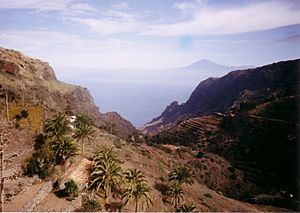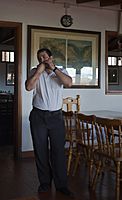Silbo Gomero facts for kids
Quick facts for kids Whistled language of the island of La Gomera (Canary Islands), the Silbo Gomero |
|
|---|---|
|
UNESCO Intangible Cultural Heritage
|
|
| Country | Spain |
| Domains | Oral traditions and expressions |
| Reference | 172 |
| Region | Europe and North America |
| Inscription history | |
| Inscription | 2009 (4th session) |
| List | Representative |
Silbo Gomero (which means 'Gomeran whistle' in Spanish) is a special way of communicating using whistles. People on the island of La Gomera in the Canary Islands use it. It's like a whistled version of the Spanish language.
Imagine trying to talk across deep valleys and narrow hills! Silbo Gomero was created to help people do just that. Messages can travel up to 5 kilometers (about 3 miles) using these whistles. Because it's so loud, people often use it for public messages, like inviting others to events or sharing important news.
Someone who speaks Silbo Gomero is called a silbador (a 'whistler'). This unique language takes Spanish words and changes them into whistle sounds. It uses a smaller set of whistle sounds to copy the sounds of spoken Spanish. In 2009, UNESCO recognized Silbo Gomero as a "Masterpiece of the Oral and Intangible Heritage of Humanity." This means it's a very important part of the world's cultural history.
Contents
History of Silbo Gomero

We don't know much about the first languages spoken in the Canary Islands, like the Guanche language. But it's thought that their sounds were simple enough to be turned into a whistled language. The original people of the island, the Guanches, used this whistled language even before Spanish settlers arrived. It was also spoken on other islands like el Hierro, Tenerife, and Gran Canaria.
When the Spanish came in the 1500s, Silbo was changed to fit the Spanish language. It was widely used throughout the 16th and 17th centuries. By 1976, it was hardly used on el Hierro, where it had been very popular in the late 1800s.
Why the Language Declined
In the 1950s, fewer people used Silbo Gomero. One reason was that the economy was not doing well. Many speakers had to move away to find better jobs and earn money. New technologies like the telephone also made the whistled language less necessary. Before, Silbo was important because it helped people talk over long distances and difficult land. It was also easy for local people to learn.
More importantly, from the 1960s to the 1980s, many families stopped working in agriculture. Some middle class families didn't want their children to speak Silbo. They thought it was only for people who lived in the countryside.
Bringing Silbo Back
In the late 1990s, people started working to bring the language back. The community began to make efforts to save it. By 1999, new education rules and other laws helped a lot. Now, Silbo Gomero is officially protected as an example of intangible cultural heritage. This means it's a special tradition that needs to be kept alive.
Who Speaks Silbo Gomero?
Many people on La Gomera understand Silbo Gomero. However, the way they speak it can be a little different depending on where they learned it.
A 2009 UNESCO report said that everyone on La Gomera understands the language. But only those born before 1950 and younger people who went to school after 1999 can "speak" it well. Older people learned it from their families at home. Younger generations learned it formally in school. People born between 1950 and 1980 understand the language but often can't speak it. This is because Silbo was not used much and was seen negatively when they were growing up.
Saving the Language
When Silbo Gomero was in danger of disappearing in the late 20th century, people worked hard to save it. Both the local community and the government helped. Their combined efforts brought Silbo Gomero back and kept it as an important part of their culture. UNESCO recorded these efforts when they chose Silbo Gomero for the 2009 Representative List of the Intangible Cultural Heritage of Humanity.
Community Efforts
To make sure young people learned Silbo Gomero, expert whistlers wanted to teach it. They got permission to teach the language for free at a special center. This idea from the older islanders was very popular. Parent-teacher groups even brought it to all schools. This was the first step in saving the language, and it started with the local people, not with big organizations. This showed how much the locals cared about Silbo Gomero. The government policies that came later were inspired by these community efforts.
Government Actions
On June 26, 1997, the Parliament of the Canary Islands asked the government to add Silbo Gomero to the school curriculum. So, in July 1999, Silbo Gomero became a required subject in primary and secondary schools. The local government helped a lot with this. They also created a formal Silbo Gomero curriculum by publishing a book called El Silbo Gomero, Materiales didácticos (Educational Materials on the Silbo Gomero).
Besides making it mandatory in schools, an Island School of Silbo Gomero was also set up. This school is for older students who want to become professional instructors. Students at this school learn to teach Silbo Gomero to locals and to tourists. This helps keep the language alive and makes sure it continues to be used.
The Ministry of Education in the Canary Islands also created a training plan for teachers. This plan helps make sure that older expert whistlers can be replaced by qualified teachers in the future. Training courses on how to speak and teach Silbo Gomero started in 2007, with 18 teachers taking part.
The government also worked to make Silbo Gomero stronger by digitizing all recorded audio. Documentaries about Silbo Gomero were shared locally, nationally, and worldwide. The government also raised the importance of Silbo Gomero. They chose it to represent Spain for the 2009 UNESCO list of Intangible Cultural Heritage.
Cultural Importance
People in La Gomera truly value Silbo Gomero. They see it as a key part of their island's identity. They use the whistled language in traditional events and celebrations. These include "bajadas," which are parades honoring the Virgin Mary or the community's patron saints.
On March 15, 1999, Silbo Gomero was declared part of the historical heritage of the Canary Islands. The annual "School Encounters with Silbo Gomero" celebration also began in La Gomera. In 2005, a monument to Silbo Gomero was placed in Garajonay National Park.
Silbo and Tourism
Silbo Gomero is not just for people from La Gomera. Visitors to the island can also experience it. Many restaurants offer demonstrations for tourists. Fernando Mendez, the Minister of Tourism for La Gomera, has said that whistling is very important for the island's tourism industry.
How Silbo Gomero Works
Silbo Gomero is a whistled form of a dialect of Canarian Spanish. It replaces each vowel or consonant with a whistling sound. Whistles are different based on their pitch (how high or low they sound) and how long they last.
Learning Silbo Gomero is complex. The whistling techniques need precise physical movements. You need strong tongue, lips, and hands, which you can only get with practice. Regular speech uses the mouth to mix different sounds. But whistling is limited to a single basic pitch between 1,000 and 3,000 hertz. The trick is to change these pitches at different speeds, and to start and stop the sounds precisely. This technique is taught in La Gomera using methods that are very old, going back to the late 1800s.
One whistle sound can represent many different spoken sounds. This means Silbo has fewer basic sounds than Spanish. Sometimes, this can make communication a bit unclear. So, the situation and the words chosen are very important for people to understand each other.
Vowel Sounds
The vowel sounds in Silbo Gomero are like long lines of high or low frequency whistles.
| Pitch | General Whistle Sound | Spoken Vowels Represented |
|---|---|---|
| High frequency | /i/ | /i/ and /e/ |
| Low frequency | /a/ | /a/, /o/, /u/ |
The high-pitched whistle for /i/ represents the spoken vowels /i/ and /e/. The low-pitched whistle for /a/ represents the spoken vowels /a/, /o/, and /u/. It's believed that you can't make vowels with in-between pitches because whistling doesn't work the same way as speaking.
Consonant Sounds
Consonants in Silbo Gomero change the "melody line" of the whistle. They can be rising or falling, or they can be broken or continuous.
Some studies suggest that Silbo has 8 to 10 whistled consonants. For example, a silent pause in the whistle can mean a "voiced" sound (like 'g'). A continuous whistle can mean an "unvoiced" sound (like 'k'). The way the whistle changes pitch quickly between vowels can show where the consonant is made in the mouth (like dental or palatal).
For example, the 's' sound is treated as a broken high pitch in Silbo. In spoken Spanish, 's' is a continuous high pitch sound. This is because the continuous high-pitched whistle already represents many other consonants (like 'l', 'n', 'r', 'd'). So, to avoid confusion, 's' was given a different whistle sound.
How Brains Process Silbo
Studies have shown that people who speak Silbo Gomero process the whistled language in their brains just like they process spoken Spanish. Researchers Manuel Carreiras and David Corina did a study in 2004 and 2005. They looked at the brain activity of two groups of Spanish speakers. One group spoke Silbo, and the other did not.
The results showed that people who didn't speak Silbo processed the sounds just as whistling. But people who did speak Silbo processed the sounds in the same parts of their brain that they use for understanding Spanish sentences. This means their brains treat Silbo as a real language, not just random whistles!
Other Interesting Facts
- Filmmaker Francesca Phillips made a 26-minute documentary about Silbo Gomero called Written in the Wind (2009). It won an award in China in 2010.
- The 2019 film The Whistlers by Romanian filmmaker Corneliu Porumboiu features Silbo Gomero a lot.
- French singer Féloche even wrote a song dedicated to Silbo.
- Other languages can also be turned into pitch sounds. For example, the Yoruba language in Africa can be played on talking drums. The drums copy the tones of the language to send messages.
See also
 In Spanish: Silbo gomero para niños
In Spanish: Silbo gomero para niños


